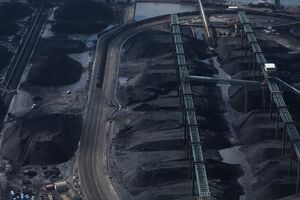Wet Dust Suppression: Difference between revisions
m Voicesinthedust access moved page Chemical dust suppression: water sprinklers and chemical sealants to Wet Dust Suppression: Conciseness |
|
(No difference)
| |
Revision as of 01:25, 4 July 2025
Coal dust emissions in Southeast Newport News and Lambert's Point are primarily managed using wet suppression methods that consist of spraying water, or water with chemical additives, over coal storage piles, railcars, and/or transloading equipment using a system of sprinklers and water trucks. Water application is often adjusted based on terminal activity and ambient humidity conditions. According to a representative from Norfolk Southern, most coal-carrying rail cars are sprayed with chemicals when they leave the coal mines, minimizing the dust emissions en route to terminals.[1]
In general, dust suppressants should be durable, protective, easy (meaning they do not significantly impede transportation processes), cost-effective, and non-toxic.A variety of formulas are on the market, including oils, waste oils, oil emulsions, latex sealants, lignin derivatives, polyacrylamides and proprietary formations, each with their own drawbacks.

Water‑based sprays
- Plain or mist water sprays are commonly installed at conveyor transfer points, rotary dumpers, hoppers, and stockpiles. They rely on fine water droplets (typically 10–200 µm) to adhere to dust and settle it out of the air oizom.com.
- Mist cannons or Dry Fog systems generate ultrafine droplets (<10 µm) to form an airborne “blanket” that agglomerates dust in enclosed areas like hoppers and tipplers amsj.com.au+1oizom.com+1.
- Surfactant‑enhanced sprays: Addition of surfactants reduces water surface tension to improve adhesion to fine, hydrophobic coal dust. This method enhances capture efficiency and conserves water compared to plain sprays globalroadtechnology.com+4oizom.com+4reddit.com+4.
- Foam suppression: Foam mixes water, air, and a foaming agent to create a lasting layer that traps dust at high‑impact zones (e.g., conveyor ends, crushers) with minimal moisture addition oizom.com+1dustsafetyscience.com+1.
Chemical sealants and binders
- Products like Nbco DustBind, DustBind Plus, DustLock, HAUL‑EZE, and HAULAGE‑DC are polymer or salt-based additives applied via spray. They form a flexible crust over coal to prevent wind erosion and self-heating, especially during rail transport and stockpile storage .
- Case: Nalco’s flexible sealants withstand rail vibrations and weather without hard cracking .
Mine‑to‑terminal chemistries
Programs like Veolia’s CoalPlus and PowerTreat apply blends of antioxidants, binders, and foam (“body‑feed”) at the loadout stage. These reduce coal oxidation, hot‑spot formation, and spontaneous combustion risks, especially in sub‑bituminous coals globalroadtechnology.com+6watertechnologies.com+6watertechnologies.com+6.
Application in railcar loading & unloading
- Railcars are sprayed with polymer coatings post-loading and mid-route to form crusts; after unloading, exteriors are washed to prevent dust migration neptuneterminals.com.
- During unloading (rotary tipplers or bottom dumps), spray manifolds activate to create full‑car spray curtains, reducing fugitive emissions reddit.com.
Emerging technologies
- Hydrogel-based suppressants (e.g. itaconic-acrylic polymer + bentonite) show ~9× efficiency increases over plain water and reduce water use by ~90% pubs.acs.org.
- IoT‑enabled systems integrate dust sensors, wind data, and automated controls to optimize chemical application only when needed oizom.com.
Concerns
Some of the chemicals are environmentally toxic and present potential problems if spray run-off and spillage is allowed to fall onto ground unprotected by a collection pad.
Documents
- Railroads of Port Adopt Coal Sprinkle: Growing demand for Sprinkled Coal Said to Be Made by Trans-Shippers, Daily Press, November 23, 1927
- Ohio Office of Air Pollution Control, Reasonably Available Control Measures for Fugitive Dust Sources (Part 1), September 1980
- Ohio Office of Air Pollution Control, Reasonably Available Control Measures for Fugitive Dust Sources (Part 2), September 1980
- Ohio Office of Air Pollution Control, Reasonably Available Control Measures for Fugitive Dust Sources (Part 3), September 1980
- Ohio Office of Air Pollution Control, Reasonably Available Control Measures for Fugitive Dust Sources (Part 4), September 1980
- City Planning Commission Meeting Minutes, City of Newport News, May 2, 2018
- Email Correspondence between Richard Posner of Dust Solutions, Inc. and Repair Lab Team Member, 2023
- Repair Lab, Coal Dust in Southeast Newport News is a Nuisance and There Are Solution (Corrected), August 2024
- Wituschek E. et al. Coal Dust Control: Recommended practices for loading, unloading and transporting coal by rail. Regional Report No. 86-17. April 1986.
References
- ↑ Lawlor, Newport News, Coal Terminals Looking Into Wind Fence, Daily Press, August 1, 2011.